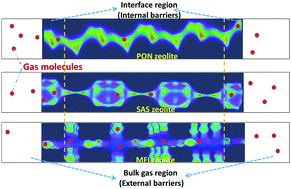Interfacial barriers to gas transport in zeolites: distinguishing internal and external resistances†
Abstract
We use atomistic simulations of CH4, H2 and CO2 transport to elucidate the effect of internal interfacial barriers on gas transport within nanoscale zeolite crystals of different morphology; such barriers are shown here to have critical significance for the performance of ultrathin membranes and nanoscale mixed matrix composite membranes for gas separation. These interfacial resistances are seen to be confined to a narrow region within the zeolite, adjacent to the phase boundary, and are distinct from the external fluid phase resistance. Our results indicate that interfacial barriers depend on the nature of the zeolite pore network, and significantly hinder gas transport in nanocrystals. We show that interaction with dense surrounding media such as a polymer enhances the interfacial resistance internal to the zeolite, and further attenuates gas transport. The relative contribution of the interfacial resistance to the gas transport resistance is more significant at lower temperatures, and this resistance is larger than the external gas phase resistance by an order of magnitude. We determine the critical membrane thickness, below which these interfacial barriers are pronounced, and find that interfacial barriers can be significant up to a thickness of about 0.1 μm. Furthermore, these interfacial barriers to gas transport are significantly higher for a gas with a kinetic diameter comparable to that of the limiting pore diameter of the zeolite (methane in this case), thus improving the H2/CH4 kinetic selectivity in finite crystals. We show that small finite crystals of SAS type zeolite are selective for H2 over CH4, while large crystals are selective for CH4 over H2.



 Please wait while we load your content...
Please wait while we load your content...